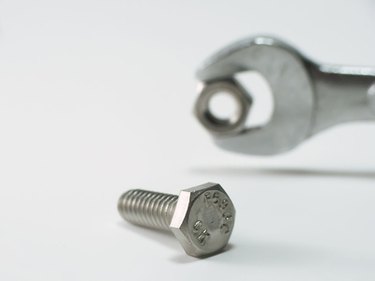
Although by their very nature, the exact dimensions of metric fasteners vary with the size needed for the job, metric bolts are constructed with specifications that require each portion of the screw to be standardized and constructed to proportions so that the dimensions of the bolt can be calculated if the size of the bolt is known.
Shank Dimensions
Video of the Day
The shank—the threaded portion of the bolt—defines the size by which a bolt is known. Manufacturers use the shank's diameter as the primary measurement of the bolt. The length of the shank varies independently of the shank's width. Hardware retailers use these two measurements to identify metric bolts: An M10x20 bolt features a 10 mm shank that's 20 cm long.
Video of the Day
Head Dimensions
The diameter between flat sections on a structural metric bolt's head is always 1.8 times the diameter of its shank. An M10 bolt with a 10 mm shank features a hex head that's 16 mm across. The shank size of bolts affixed into a solid surface can be determined by measuring the head's dimension and dividing by 1.8. A nonstructural bolt's shank-to-head ratio is 1.6.
Head Clearance
Because the width between opposing sides on a hex head bolt's head is a function of the shank's dimension, the distance between opposing points on a structural bolt's hex head is also standardized at two times the width of the bolt's shank. On nonstructural bolts, this is 1.8 times the shank's diameter.
Head Depth
On structural and nonstructural bolts, a metric bolt's hex head is 0.7 the diameter of its shank. Thus the head of an M10 bolt, with its 10 mm shank, will be raised 7 mm from the fastening surface when fully tightened.